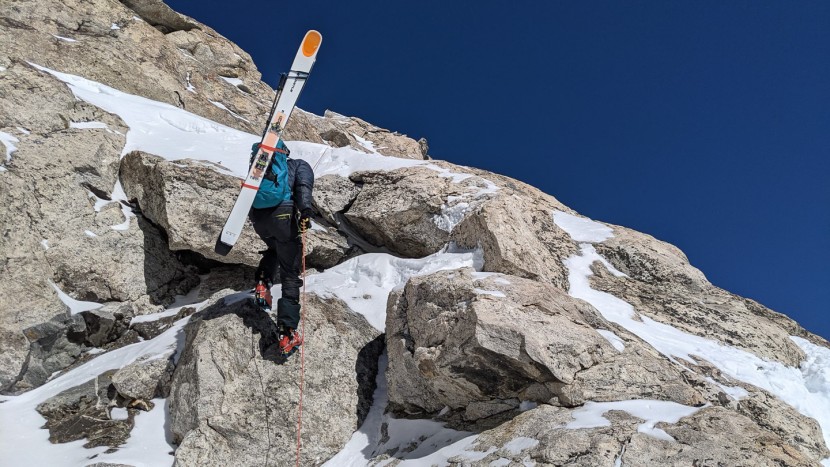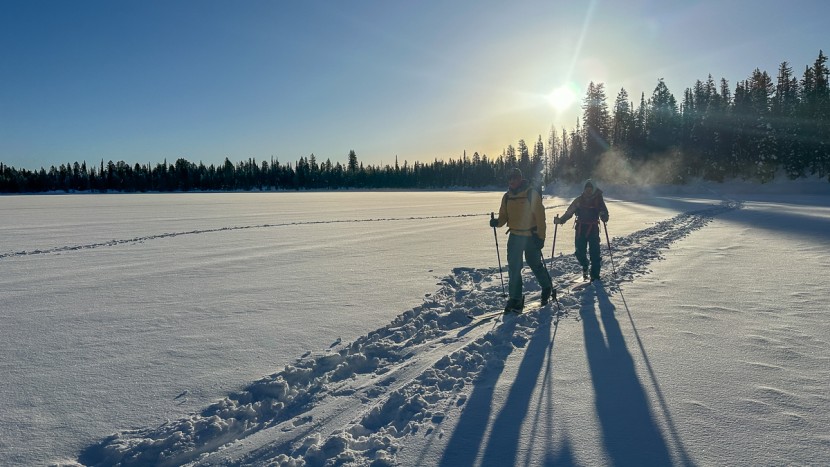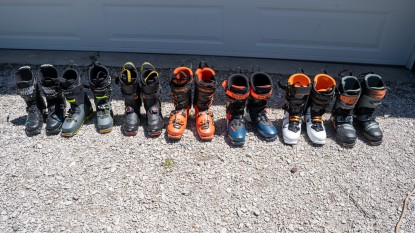Tecnica Zero G Tour Pro Review

Our Verdict
Our Analysis and Test Results
At first glance, the Zero G Tour Pro looks just like other efforts from major boot manufacturers: Take your typical resort-optimized, wrap-constructed, all-mountain ski boot and slap a walk mode and tech fittings in it. In recent years, nearly all ski boot manufacturers have made a stab at this type of boot, though the results have been varied. We have really enjoyed skiing these modified alpine boots downhill, though all of them have suffered on the uphill.
Tecnica really stepped up the game by offering a boot that strikes the ski-to-tour performance balance as well as anything on the market at a virtually unbelievable weight. The difference with the Zero G, compared to the so-called “hybrid” boots, is that it was designed from the ground up to be a backcountry ski boot. Recent updates have even improved touring performance compared to previous models—they made the best better, without any setbacks that we could detect.
Downhill Performance
If you've dreamt of high-speed stability from a pair of AT boots, or your downhill skills are a touch less than “expert,” then you shouldn't settle for anything less than the performance offered by the Zero G Tour Pro. These boots are tuned to go fast and stiff enough to drive big skis. The lateral support is solid, and the forward flex is progressive and smooth. However, the rearward support is notably less than that of some of the heavier boots we tested. This boot rewards centered, balanced skiing – if you get sloppy and ski in the back seat, then the Zero G will lightly punish you for the indiscretion.
At this weight, no other boot in our review skis better than the Zero G. Tack on a few ounces, and you get a small, albeit noticeable, improvement in downhill performance. However, it is so minor that some might not notice it at all. That tiny boost in performance comes at the cost of extra weight, more friction in the cuff, less range of motion in tour mode, and some additional fiddle factor. All told, there is no boot in our lineup that balances downhill performance and weight like the Zero G Tour Pro.
Uphill Performance
We used to make some generalizations about boot construction and uphill performance – that boots with “overlapping” shells don't tour as well as ones designed with a “tongue.” Up until recent years, our generalizations were largely fair, but the Zero G shatters that conception. This overlapping (2-piece) shell tours better than many tongue-style boots (a term that may become obsolete, as modern designs in that same spirit don't feature an actual tongue piece any longer).
The range of motion of the Zero G is more than most ankles can actually flex, and the newest version includes an even greater range of motion. The friction (or lack thereof) has also been improved and is low enough to drive a stick shift while wearing them. Our driving assessments aside, these boots tour better than all but the most uphill-focused boots in our review. Considering their downhill performance, they tour amazingly well. The Zero G Tour Pro has recalibrated our understanding of what sort of uphill-to-downhill balance is possible.
Weight
These boots would have been the lightest “performance” ski boots on the market just a few years ago. A single-boot weight of 1445 grams is totally reasonable for even the most severe of ski mountaineering endeavors. Of course, you can go lighter, though downhill performance will quickly diminish with every 100 grams shaved. You can also find boots that are quite a bit heavier than the Zero G, though with relatively little gain in downhill performance and major setbacks on the uphill.
Solid, all-around backcountry ski boots weigh around 1300-1400 grams, per boot. Many other well-established boots hit these numbers, and it has long been a collective design goal to achieve high performance from a boot of this mass. On the scale, the latest version of the Zero G Tour Pro weighs just a little bit more than the earlier generations, but not by enough that you'd notice.
Just because we go on and on about the performance-to-weight ratio of the Zero G, however, don't overlook the uphill efficiency gains of a lighter-weight boot. Weight savings aside, lighter boots generally have less friction in their cuff in tour mode. As with all backcountry ski gear, there will be tradeoffs, and it's worth considering the balance of uphill and downhill performance of a few lighter options against the relatively heavy Zero G Tour Pro.
Comfort and Fit
We fit the Zero G Tour Pro to multiple testers, which allowed us to make direct comparisons of an unaltered AT boot. Compared to the spectrum of boots we tested, we now consider the Zero G to be on the narrower side of average fit. The last of the boot hasn't changed, but the market has – more and more boots offer wider lasts, and many skiers have become accustomed to this type of fit. Our test team, however, like this close-fitting Tecnica boot, especially as the fit pertains to downhill performance.
Folks with average to narrow feet will get the support they need from this stock boot. Others with wider feet can reap all of the performance benefits of these excellent boots with a bit of work. Aside from rough generalizations, we hesitate to offer direct comparisons. Fit of ski boots is so subjective, and slight modifications by a professional boot fitter is common practice. While the lucky skier is one who can ski his or her boots “right out of the box,” just know that a high-quality boot fitter can work near miracles.
Warmth
In our testing, we've found that ski boots have a wide range of insulation values. As boots get more and more specialized (read: lighter weight), insulation is even more variable. A few iterations ago, Tecnica slimmed down the plastic and the liner material of the Zero G to improve overall performance, especially on the uphill. The result, however, isn't diminished insulation value.
Backcountry skiing takes place in cold settings and environments, so few other comments on the insulation of ski boots are peculiar. However, a few testers with chronically cold feet noted that the Zero G didn't feel like a particularly warm boot. With careful fitting and intentional accessorizing (like heated socks), this boot works well in particularly cold climates and can be pressed into expedition work. We just wanted to provide a word of caution – there are a few similar boots with slightly thicker shells that feel warmer than the Zero G.
Ease of Use
The Zero G Tour Pro is built around a well-proven formula. A boot with four buckles, a power strap, and an external ski/walk mode lever is simple, familiar, and reliable. Other comparable boots employ all sorts of innovative and experimental usability attributes, which Tecnica designers avoided. Sure, you can get used to the quirks of more “innovative” equipment, but why bother when this boot is so good and reliable?
The ski/walk mode locks securely, even when moderately iced up. All boots with overlapping shells are slightly tougher to get in and out of than tongue-style boots, though it really only presents an issue getting out of a cold sleeping bag. We appreciate a streamlined transition and the simplicity of “one-move” boots, which is not the case with the Zero G. This boot takes up to four moves for every transition, but we admit that this is the case for almost all high-performance AT ski boots.
Should You Buy the Technica Zero G Tour Pro?
There was a time not that long ago when all of the top-of-the-line AT ski boots edged over $1000. We are thankful that time is past. The Tecnica Zero G Tour Pro isn't cheap, but the price point is in line with other top-tier models in our lineup. While average prices have trended down, the flipside is that budget ski boots are less available. It's harder to save hundreds of dollars by compromising a bit of performance. Considering that you're going to spend a similar amount on basically any modern touring boot, it's worth investing in something like the Zero G Tour Pro: a high-quality boot designed to last.
What Other Backcountry Ski Boots Should You Consider?
The Zero G Tour Pro nails the sweet spot for ski touring and ski mountaineering. The good news is that AT ski boots are so good these days that even if you need to save some cash by opting for a better value like the La Sportiva Vega, you really aren't sacrificing much performance. While the Vega and Zero G Tour Pro ski similarly, if you'd rather opt for a lighter-weight boot that enhances uphill performance, it's worth considering either of these boots against the Scarpa F1 XT.
| Awards | Best All-Around Backcountry Ski Boot |
|---|---|
| Price | $980 List Check Price at Backcountry |
Overall Score  |
|
| Star Rating | |
| Bottom Line | An excellent ski boot that quietly entered the market and continues to crush the competition |
| Pros | Excellent downhill performance, lightweight, proven style |
| Cons | Moderate insulation, difficult to get in and out of if cold |
| Rating Categories | Tecnica Zero G Tour Pro |
| Downhill Performance (35%) | |
| Uphill Performance (20%) | |
| Weight (20%) | |
| Comfort and Fit (10%) | |
| Warmth (10%) | |
| Ease of Use (5%) | |
| Specifications | Tecnica Zero G Tour Pro |
| Weight per Pair (Size 26.5) | 6 lbs 6 oz |
| Binding Compatibility? | MNC, Tech |
| Measured Range of Motion (degrees) | 98° |
| Manufacturer Stated Last Width | 99 mm |
| Weight of One Complete Boot, No Insole | 1445 g |
| Weight of One Boot Shell | 1212 g |
| Weight of One Stock Liner, No Footbed | 233 g |
| Stated Flex Index | 130 |
| Liner Design | Tongue |
| Shell Material | Grilamid |









